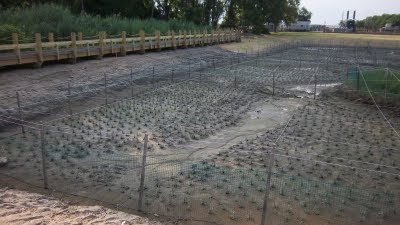- On the west bank of Alley Creek, very close to the center, (400 45’ 44.95”N and 730 45’ 07.23”) there is a two acre upland and marsh restoration.
Monday, July 18, 2011
CAN WE RESTORE THE WETLAND NATURE PRESERVE???
Monday, July 11, 2011
THE WATERS WE SHARE - PUBLIC MEETING
The plan is ambitious in scale, scope and timetable. It lays out how this region might ‘restore’ the health and vitality of the estuary through water quality improvements and by restoring key ecological habitats over the next 40 years! The harbor region is divided into 8 restoration regions and Little Neck Bay and the Alley Wetland Preserve are included in the “Harlem River, East River and Western Long Island Sound” unit. This may sound like a strange association of different places but actually it is a unified watershed with all of the lands draining into the tidal channel of the East River. I’ve written on other occasions about the special nature of the East River and would like to revisit those ideas someday soon but for now I can say that because of its connection to both Long Island Sound (to the east) and New York Harbor (to the west) the Upper East River is a very special connecting water body. You really can’t understand the nature of the water flows in this region without coming to grips with the tidal nature of this channel.
As for the meeting itself, Lisa Baron of the USACE presented the comprehensive view of restoration opportunities. Five specific habitats are the targets for restoration. On the maps that were presented I noticed that Little Neck Bay stood out prominently in at least three of the major restoration categories –coastal wetlands, oyster reefs and eelgrass beds. Wouldn’t it be fabulous to have oyster reefs and eelgrass beds in the bay once again! The bay has plenty of room and plenty of opportunity for all of these ecological improvements. I would also add that this valley also has an undetermined potential for the other two target systems -islands for water birds and maritime forests although these were not shown in the current plan.
Large scale, regional restoration needs to be done in a coordinated way but it also needs to be done on a case-by-case project-by-project basis. This plan is trying to do both- maximizing the site specific projects while coordinating the big picture for the region. There is much for all of us to learn from this. The following three web sites will take the interested reader to a good starting point.
The Waters We Share website
http://www.harborestuary.org/watersweshare/
The Waters We Share brochure
http://www.harborestuary.org/watersweshare/pdfs/HEP-Brochure.pdf
Comprehensive Restoration Plan
http://www.harborestuary.org/watersweshare/resources.htm#crp
Next time I think I need to write specifically about some of the restorations that are already underway in and around the preserve. We certainly do live in exciting times.
Friday, July 1, 2011
PUTTING THINGS IN PERSPECTIVE
Nature neglected.
Nature forgotten.
Nature ever-changing.
Nature resilient.
Nature in the City.
Nature beloved..
All of these and many more can be found just a few steps inside this great preserve.
Now, while there will never be a shortage of topics to write about, I also have to consider the position of this preserve within its larger context. Geography is important. Where things are and how they are connected need to be understood if you are to really understand the nature of a ‘place’.
One of the most productive ways to understand the geography of this preserve is in terms of its 'watershed’. The idea of "watershed" is a fundamental geographic idea and is essential to the development of landscape. The watershed of the wetland preserve is a much larger unit than the preserve itself. (See map at the end of this post) It is defined by water flows and hydrology. Water is the liquid connective tissue analogous to the blood and the circulatory system of the human body except that the water in this area is largely open and renewable and not flowing in a closed loop physiological system.
Our particular watershed sits on the eastern most edge of
It is also a highly humanized place. Place names like Oakland Lake, Udalls Cove and Ravine,
I still love to write about the Wetland Preserve but to do justice to that goal, I have to put it in its proper context. The Alley Watershed is that context. So my future plans may include some of the places, creatures and events that exist throughout this surrounding area.



